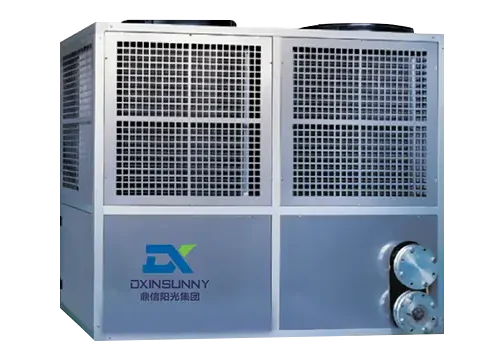Core Advantages

Energy Efficiency and Heat Source Utilization
- Absorption heat pump units are highly energy-efficient and can make use of a wide range of heat sources. They can utilize low-grade heat such as waste heat from industrial processes, solar-heated water, or geothermal energy. This not only reduces energy waste but also provides a sustainable way to heat and cool. The versatility in heat source compatibility allows them to be integrated into different energy systems.
Quiet, Reliable, and Safe Operation
- These units operate quietly due to the absence of a traditional mechanical compressor. They have a stable and reliable design with components that are less prone to wear and tear. Absorption heat pump units are also safe as they do not involve high-pressure refrigerants. Additionally, they have a long lifespan, making them an economical choice in the long run.

Energy Efficiency and Renewable Energy Utilization

Versatile Heat Source Compatibility

Stable and Reliable Operation

Efficient and low-noise operation

Safety

Long Lifespan

Energy Efficiency and Renewable Energy Utilization
- Absorption heat pump units are highly energy – efficient. They can utilize low – grade heat sources such as waste heat from industrial processes, solar – heated water, or geothermal energy. For example, in an industrial plant, the unit can recover waste heat from production processes that would otherwise be dissipated into the environment. This not only reduces energy waste but also provides a means of recycling heat energy. The ability to use renewable or waste heat sources makes it a sustainable option that can contribute to reducing the overall carbon footprint.
Versatile Heat Source Compatibility
- Absorption heat pump units can work with a wide range of heat sources. Besides the aforementioned waste heat and renewable sources, they can also use natural gas or steam as a heat source. This versatility allows them to be integrated into different energy systems and environments. For instance, in a district heating system, the unit can be adapted to use the available heat sources in the area, whether it’s waste heat from a local factory or steam from a power plant.


Stable and Reliable Operation
- Absorption heat pump units have a relatively simple and robust design. The components are less prone to mechanical wear and tear compared to systems with complex moving parts like compressors. This results in a more stable and reliable operation. They can run continuously for long periods without significant breakdowns, providing consistent heating and cooling services.
Efficient and low-noise operation
- Noise reduction technology is used to ensure that the device maintains a low noise state during operation, creating a quiet living and working environment for users.
- It maintains silent mode while operating efficiently, suitable for installation in bedrooms or office areas, without interfering with daily activities.


Safety
- Absorption heat pump units are generally considered safe. They do not involve high – pressure refrigerants as in some other heat pump systems. The absence of such high – pressure components reduces the risk of refrigerant leaks and associated safety hazards, making them a safer choice for both indoor and outdoor installations.
Long Lifespan
- With their simple design and less – prone – to – wear components, absorption heat pump units often have a long lifespan. They can provide efficient heating and cooling services for many years, reducing the need for frequent replacements and associated costs. This long – term durability makes them an economical choice in the long run.

Product Specifications
| Product Specification | Details | Product Specification | Details |
| Heating Power | 6.0 kW | Energy Efficiency Rating | A++ |
| Refrigerant Type | R410A | Applicable Area | 50-150㎡ |
| Power Supply Voltage | 220V / 50Hz | Noise Level | ≤25 dB |
| Dual Inverter Technology | Supported | Smart Temperature Control | Supported |
| Remote Control | Mobile App Remote Control | Auto Defrost Function | Supported |
| Operating Temp Range | -15℃ to 45℃ | Weight | 40 kg |
| Dimensions (L x W x H) | 850mm x 300mm x 650mm | Installation Method | Ceiling / Wall Mounted |
Absorption heat pump units unit Feature and Application:
Low-Grade Heat Utilization:
The absorption heat pump unit has the unique ability to utilize low-grade heat sources. This includes waste heat from industrial processes, solar thermal energy, or geothermal heat. For example, in an industrial setting, the heat pump can capture and upgrade the waste heat from manufacturing operations to provide heating or cooling for other parts of the facility. This feature not only reduces energy waste but also makes it possible to harness otherwise unused energy sources.
Quiet Operation:
Unlike traditional mechanical compression heat pumps, absorption heat pumps operate quietly. This is because they do not have a noisy compressor. The absence of a compressor makes these units ideal for applications where noise levels need to be minimized, such as in hospitals, hotels, and residential areas.
Thermal Storage Capability:
Some absorption heat pump systems have the ability to store thermal energy. This can be useful for load shifting and providing continuous heating or cooling even when the heat source is not available. For instance, a solar-powered absorption heat pump can store excess heat during the day for use at night or during cloudy periods.
Economic and Social Benefits:
For businesses,this unit reduces energy costs and offers a quick return on investment. On a societal level, it aids in balancing energy demand, cutting emissions, and promoting sustainable development.
Application:

Industrial Processes:
Absorption heat pump units are widely used in industrial settings. They can recover waste heat from various industrial processes such as chemical manufacturing, food processing, and textile production. For example, in a chemical plant, the unit can capture the waste heat from reactors and use it to pre – heat raw materials or provide space heating for the plant. This not only reduces energy consumption but also cuts down on operating costs and greenhouse gas emissions.

District Heating and Cooling
In district energy systems, absorption heat pumps play a crucial role. They can utilize waste heat from power plants, sewage treatment plants, or other large – scale heat – generating facilities. The recovered heat can be used to provide heating and cooling for a group of buildings in a community. This is an efficient way to manage energy resources and provide a sustainable heating and cooling solution for urban areas.

Commercial Buildings
Absorption heat pump units are suitable for commercial buildings like hotels, shopping malls, and office buildings. In a hotel, for example, the unit can use waste heat from the laundry or kitchen to provide hot water and space heating. The quiet operation of the unit is an added advantage in these noise – sensitive environments.

Renewable Energy Integration
Absorption heat pumps are excellent for integrating with renewable energy sources such as solar and geothermal energy. In a solar – powered system, the heat pump can use the heat collected by solar thermal collectors to provide heating and cooling. This combination maximizes the utilization of renewable energy and reduces the reliance on conventional energy sources.

Commercial and Residential Buildings:
this unit recovers heat from ventilation systems, refrigeration equipment, or exhaust gases in large buildings, shopping malls, and residential complexes, which can be used for heating or hot water supply.

Agriculture and Aquaculture:
Can be used in greenhouses or fish farms to maintain optimal temperatures, improving productivity while reducing energy costs.
Absorption heat pump units unit Details
Working Principle:
The Absorption heat pump units operate on the reverse Carnot cycle or vapor compression cycle. It takes low-temperature waste heat and upgrades it to a usable temperature using refrigerants and mechanical work. The basic steps include:
Heat Absorption:
The absorption heat pump unit absorbs low-grade heat from a heat source. This heat source can be waste heat from an industrial process, solar energy, geothermal energy, or other sources. The heat is transferred to a working fluid within the unit.
Compression:
The refrigerant is compressed in the compressor, raising its temperature and pressure.
Heat Release:
The heated refrigerant transfers its energy in the condenser to a secondary medium (such as water or air) for space heating, industrial processes, or hot water supply.
Expansion and Recycling:
The refrigerant expands and cools through the expansion valve, returning to its original state and repeating the process.


Efficiency and Performance:
The Coefficient of Performance (COP), a key measure of efficiency, typically ranges from 3 to 6, meaning for every unit of electricity consumed, the unit can produce 3 to 6 units of heat energy.
The system can efficiently upgrade low-grade heat (from as low as 10°C or 50°F) to usable temperatures (as high as 90°C or 195°F), depending on the application.
By recovering heat that would otherwise be wasted, the system significantly reduces energy consumption and operational costs.
Frequently asked questions
The main advantage is its ability to utilize low-grade heat sources, making it energy-efficient and environmentally friendly.
It can use waste heat from industrial processes, solar thermal energy, geothermal heat, natural gas, and steam.
Maintenance requirements are relatively low. Regular checks on the heat source, fluid levels, and valves are recommended. Generally, it may require less frequent maintenance than compression heat pumps.
With proper maintenance, absorption heat pumps can have a lifespan of 15 to 20 years or more.








